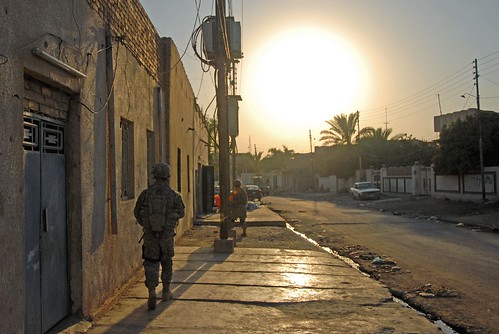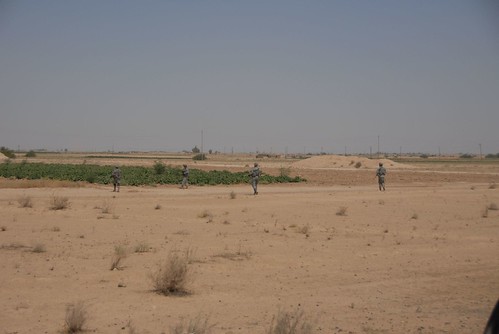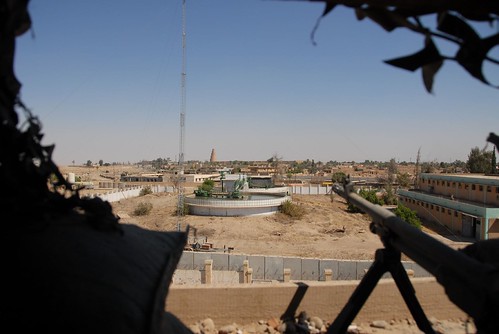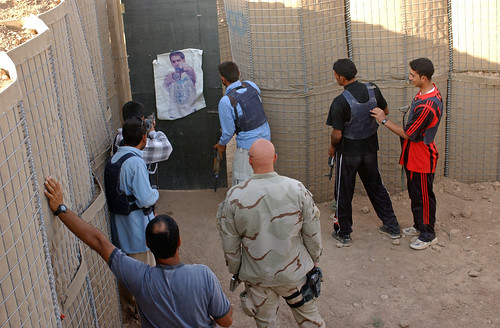The situation in Iraq is incredibly complex -- and the products of the ‘Surge’ are far too fragile to survive a Coalition drawdown (Part 1 of 2)
By Jeff Emanuel
October 22, 2007
**Note: Click here for the rest of Jeff's reports from the front lines in Iraq.**
Samarra, Iraq
In January of this year, General David Petraeus was unanimously confirmed by the U.S. Senate to take command of multinational forces in Iraq. After the failed strategy of General George Casey, now Chief of Staff of the Army, Petraeus and his new ideas for how best to handle the situation in Iraq were seen as a breath of fresh air -- not to mention a last option for an administration whose Party and legacy have been tied inexorably to the outcome of its abortive nation-building effort in the Middle East.
A successful commander in Iraq (with the 101st Airborne in Mosul), the holder of a Ph. D from Princeton, and the author of the Army’s new field manual on Counterinsurgency (FM 3-24), Petraeus brought with him a new approach to the fight to secure Iraq from the insurgent and terrorist population which had taken hold there. To carry out his plan, he requested – and was granted – a 30,000-soldier ‘surge’ in troop levels, the main effort of which was tasked with securing Baghdad, the extremely large capital city which is as rife with sectarian fault lines and, in many areas, as violent as can be imagined. Further, the Coalition’s combat power would be moved out of the obscenely large (and, believe it or not, relatively plush) ‘Super FOBs’ (Forward Operating Bases) established and built up under General Casey, and would once again (like in 2003-04) be based out of myriad tiny Patrol Bases and Combat Outposts, located out in the midst of each occupying unit’s area of operations and sector of responsibility.
This is a key difference between Petraeus’s strategy and that of General Casey, which involved pulling Coalition forces back to giant bases and minimizing the friendly foreign presence in sector in favor of putting forward an Iraqi security force and government which simply, and unfortunately, was not ready to take that step.
Sustained Presence
A sustained presence within the cities and rural areas that each unit is tasked with securing, involving spending the maximum amount of time possible out amongst the people who live and work there, is a major element of counterinsurgency strategy. It not only allows the unit responsible for an area to be present and able to respond at a moment’s notice to any event or emergency, but also allows the members of that unit to become more familiar with the district (and the people, including who should and should not be there) that they are responsible for policing.
Such a policy also allows the civilians in the area to become familiar with and begin to begin to trust their military protectors. Building this bond of trust between military personnel and civilians in each area should lead at some point to cooperation, both in the form of providing information (the first step) and (later) in the form of the organization of an armed resistance working with the Coalition and against the insurgents and terrorists in the region. This is a very long, tortuous process, and it literally depends on the clichéd ‘winning of the hearts and minds’ of the people. This is done not only by providing security and quality of life improvements in an area, but also by convincing the citizenry that such a sustained presence (and the security that it is capable of providing) will be a long-term reality. Once that concept is established as accepted fact, the populace would be acting in their own best interest to turn on the insurgency in favor of taking advantage of what the Coalition has to offer them.
Along with unanimously confirming Petraeus and this strategy in January, Congress agreed to wait until the middle of September to cast judgment on the effectiveness of the new course in Iraq.
Hasty Declarations of Failure
As any conscious American is well aware, within weeks of unanimously approving both the new commander and the new direction, many in Congress were out in front of microphones and television cameras, declaring that “The Surge has failed” and “The war is lost,” and announcing the appallingly-named (to say the least) “slow bleed” strategy to drain the soldiers in Iraq of the funding and supplies necessary to fight the war, while also sponsoring and appearing in television advertisements designed to drain what little public support remained for the securing and rebuilding effort there. While lip service was paid (at the beginning) to granting Petraeus the time and resources necessary to fully implement his plan, politics quickly trumped patriotism and honest dealings, and attempt after attempt was made to cut him off at the knees and to declare failure before his strategy had ever even been implemented. This lack of unity at home greatly damaged the credibility of America and of her forces in the Middle East, who were (and are) dependent on the Iraqi people's ability to trust that the Coalition will not abandon them, whatever the cost, in order to be able to make any real, long-term gains on the ground there.
It was not until June -- weeks after Senate Majority Leader Harry Reid (D-Nev.) had declared that the strategy had “failed” -- that the entire cast ‘Surge’ troops had arrived in Iraq and been positioned to carry out their mission, leaving only two months for fully-manned counterinsurgency operations before Petraeus’s testimony to Congress on progress in Iraq was due.
Winning a Counterinsurgency Takes Time
This is a war (and postwar) that is being waged against an enemy who relies on the stunningly efficient execution of public relations and propaganda/information operations as much as it does on terrorism and battlefield action.
It is being fought against people who recognize none of the same rules of war – let alone of decency and human conduct – that we do. This effort depends on the trust, bravery, and action of a terrorized population for success, and the idea that significant and lasting progress could be made in a mere two months is absurd. Unfortunately, the fast-food, attention-deficit, immediate-results culture which America has become appears to have neither the patience nor the attention span required to take into account the indescribable complexities of the situation in Iraq, let alone to fathom the million variables and moving parts which must all fall into place and begin to work in concert for Iraq to even have a chance to be what we would think of as a ‘normal’ or stable state. In the real world, the country (or the planet) is not saved by the end of a half-hour show, a two-hour movie, or a twenty-four week television season. Unfortunately, the moviegoing culture in the United States appears to have long since lost sight of this fact.
A successful counterinsurgency a long and difficult process, and five (or even ten) years is none too long a time to expect it to take for such operations to succeed – if success is even possible. This is always an open question in a counterinsurgency, especially since success is largely dependent on factors such as the attitude, trust, and courage of the indigenous population -- factors which are not under the direct control of the nation attempting to execute such operations.
However, to wage a successful counterinsurgency and then to build a stable, autonomous, self-sufficient, secure state, which can be left behind entirely by the occupying army without risking its imminent collapse, is another matter altogether, and is an undertaking whose success is, if possible, even less guaranteed – let alone feasible in the matter of mere months.
 |
The Gains so far
That having been said, the ‘Surge’ in Iraq, and the counterinsurgency strategy that the increase in forces was designed to support, has, in just that very brief span of time, resulted in gains far beyond what most people familiar with the situation there could have realistically expected or imagined. A large part of the reason for this is the fact that, in many different ways, a portion of the population of Iraq -- not large enough, but a difference-making portion all the same -- has shown bravery that we can only hope that Americans, if put into the same situation, would be capable of showing.
 In the massive swath of western Iraq that makes up Anbar Province -- including its major cities of Ramadi and Fallujah, which many in the Coalition were all but ready to write off entirely as recently as last summer -- progress unhoped-for and unimagined seemed to come from nowhere, and blossomed into the ‘Anbar Awakening.’ This saw the numerous tribes and clans of the region putting aside their historical differences and banding together (with a Coalition force that they could not be sure would even be present to help protect and secure them within months of their action) to drive out the majority of al Qaeda in Iraq (AQI) and other terrorists from their territories.
In the massive swath of western Iraq that makes up Anbar Province -- including its major cities of Ramadi and Fallujah, which many in the Coalition were all but ready to write off entirely as recently as last summer -- progress unhoped-for and unimagined seemed to come from nowhere, and blossomed into the ‘Anbar Awakening.’ This saw the numerous tribes and clans of the region putting aside their historical differences and banding together (with a Coalition force that they could not be sure would even be present to help protect and secure them within months of their action) to drive out the majority of al Qaeda in Iraq (AQI) and other terrorists from their territories.Whether this alliance of tribes will last into the future, once there is no longer a common enemy who offers to the people there, in the words of one tribal sheik, “only death,” is another matter altogether. But, if the counterinsurgency mission in Iraq is to end in a successful exercise in stable nation-building, then that issue will have to be addressed at some point in the future.
Trouble Ahead?
In all likelihood, once the larger enemy has been destroyed or driven out to a sufficient degree that such an alliance is no longer absolutely necessary for survival, the tie that binds these tribes and sects together will dissipate, and violence and competition between these historically opposed groups will once again build to a level that will shock the casual observer back home in America into once again writing off the region as being one that is beyond both help and hope. Whether American resources (if we are even still in Iraq at that point) will be shifted back into the West from wherever they happen to have been placed at that time in order to deal with this hypothetical -- but extremely likely -- rise in violence in what is currently a relatively peaceful region of the country cannot be determined at this point. It is simply a decision that will have to be made when that eventuality occurs.
While a long-term view of Iraq, and its future issues, must be considered (with far more care than the nation’s future was thought through at the time of the initial invasion), those tasked with making tactical, strategic, and policy-level decisions on Iraq must not lose sight of the now in favor of analyzing every possible future issue. The decision-making process must not fall victim to the paralysis that can be brought on by overanalysis of future possibilities, lest America’s current effort be inadvertently and fatally undermined.
At the present, in other areas, success has been slower, and results much more recently achieved, but they have come in concert with, and have in some cases been an inarguable result of, General Petraeus’s new direction in Iraq. Increasing the Coalition troop presence, moving the forces there back out into the communities they are responsible for securing, as well as moving soldiers into areas that were abandoned by the Coalition after the initial invasion of 2003, has resulted in increased security and more insurgents killed and captured --a result that even those with no knowledge of military operations or of the situation in Iraq should have been able to predict.
Further, major offensive operations have resulted not only in scattering the various enemy elements here, but also in killing and capturing terrorists in massive numbers. This summer, for example, Operations Arrowhead Ripper and Lighting Hammer smashed the al Qaeda infrastructure in the Diyala Province city of Baqubah (the self-proclaimed seat of the Islamic State of Iraq’s “21st Century Caliphate”), and Operation Marne Huskey pressed the Coalition’s advantage against AQI and Jaish al Islam in an area south of Baghdad whose only exposure to a persistent Coalition presence since 2003 began when one of the ‘surge’ Brigades was dispatched there in May of this year.
Calls for a Draw-Down
Close on the heels of these small, incredibly short-term gains have come calls for the U.S.’s next move in the region to be the drawing down of the ‘surge’ troops, followed by a progressive withdrawal of even more soldiers, with the ultimate goal being an almost complete turnover of security operations to Iraqi forces within the next three years. These recommendations have come from various quarters, including, reportedly, Admiral William Fallon, the head of U.S. Central Command, which oversees the operations in the Middle East.
President Bush himself has declared that within the next few months, at least a number equivalent to that of the ‘surge’ – 30,000 U.S. troops – will likely be brought home from Iraq, regardless of the state of affairs on the ground in that country. Secretary of Defense Robert Gates, apparently as out of touch as ever on Iraq, has said that he “hopes” to draw down troop levels far more quickly than the President. Even General Petraeus, likely under pressure from an administration that still appears to cling to the belief that, if enough concessions are made, the approval of the American Left will one day (somehow) be given, has said that such a move is entirely possible.
If the goal of the administration, the Department of Defense, and the country is actually to succeed in their stated goal of leaving behind an Iraq that even remotely resembles a secure state that is not a safe haven for terrorists and their operations, then agreeing to this course of action would be a mistake, as well. If they hope to achieve the further objective of establishing a successful state -- democratic or not -- in the land that Saddam once ruled, then a withdrawal would be even more counterproductive.
The actual combat troop strength currently in Iraq is, in reality, still far too low to clear, hold (or "secure"), and build – the three pillars of counterinsurgency – the entire country let alone to nation-build successfully. Field Manual 3-24 (Gen. Petraeus’s treatise on Counterinsurgency) states that 20 soldiers for every 1,000 people is an ideal number to successfully wage such an effort. Given the 27 million person population of Iraq, such a ratio would demand that a staggering (and currently impossible) 540,000 combat troops be in Iraq at any given time. The fact is that, in essence, fewer soldiers than it would take to fill up Washington, D.C.’s RFK Stadium have been asked to secure and patrol a nation the size of California, while also training Iraqi Security Forces and performing reconstruction projects. A very small minority of the 140,000 total troops here in Iraq are performing combat operations, as the majority of the soldiers are support troops who rarely leave their FOBs).
Further, for the units that are in Iraq, a continual state of being grossly undermanned is the rule rather than the exception at this point. Southeast of Baghdad, for example, in the area around Salman Pak, two companies from the 3rd ID’s 1-15 Infantry (neither of which possesses a single platoon that is even close to being fully manned) are responsible for securing a twelve-mile string of cities and villages up the Tigris River Valley to Baghdad. The rte also responsible for “interdicting accelerants” (both people and materiel) on their way to Baghdad from central Iraq and from Iran (as a major highway connecting the two sits in their area of responsibility), and for clearing and holding dozens of square kilometers of open agricultural land to the east. They must do all of this while also conducting clinics, holding governmental and tribal meetings, refurbishing schools, training police, and conducting day and night patrols.
Mere Company-sized elements, like Samarra-based Charlie Co. 2-505 (from the 82nd Airborne), have not only been tasked with clearing, controlling, and policing entire cities (in this case, the less than 200 soldiers of C Co. and a single Special Forces team are the only Coalition force present in and around the 170,000-person city of Samarra), but also with doing the same in great swaths of surrounding land. Not even a battalion-sized element could patrol such an extent of territory effectively, for it include not only towns but massive hinterlands that can (and do) serve as perfect hideaways for terrorists and their materiel.
In less populous areas, like the region of extreme northwestern Iraq near Tal Afar, where one Cavalry Squadron and one Special Forces team are the only Coalition presence in a very large area, far more terrain must be covered by far fewer troops than could ever effectively clear and hold it -- let alone possibly secure it.
 |
These examples are much closer to the norm among American units in Iraq than most realize. While the sheer number of soldiers that are present in Iraq may sound large to the layman at home in the United States, our effective combat footprint, when matched up against a map of Iraq (comparable in surface area to the state of California) is frighteningly small.
However, despite the inhospitable human and geographic environment, the troops who have been asked to take on this massive task have performed admirably, often performing deeds worthy of heroic remembrance in pursuit of their mission, as well as in their quest to save the lives of others – both American and Iraqi – all the while being targeted by terrorists who would rather slaughter their own countrymen in the process of fighting the Coalition than actually stand and fight an army toe-to-toe. The strain of extended combat tours (the continuation of which, in the words of one Captain of Infantry, “will break the Army”) has not stopped them. Neither has the fact that the operational head of the military, Secretary of Defense Robert Gates, has appeared since his confirmation hearing to be woefully out of his depth in his position of leadership in the Pentagon and, has steadfastly refused to visibly buy into the mission that his forces are tasked with carrying out (and dying for) in Iraq.
Editor's Note: Part 2 will appear tomorrow.
Jeff Emanuel, a special operations veteran of Operation Iraqi Freedom, was embedded with the U.S. military in Iraq both in April and May, and from August through October, of this year. His reports, which are 100% funded by reader donations, can be seen at www.JeffEmanuel.com.
3 Comments:
- At 11:03 AM, said...
-
Jeff - a great post, just a nit to pick. Are you sure they call themselves "Baker" company? Most US Army companies are known by their position in the modern military phonetic alphabet, used for radio communication. Thus, in modern lingo, the companies in a battalion would be Alpha, Bravo, Charlie, Delta, Fox Trot, etc. "Baker" would be from the old alphabet used in World War II, which began "Able, Baker,...".
Best Regards - At 10:27 PM, Jeff Emanuel said...
-
Yes. Here's visual evidence. It's because of their Audie Murphy heritage.
I'm aware that it's neither modern nor ordinary -- but then again, neither is this company, which I had the privilege of spending the first 3/4 of August with in the Salman Pak area south of Baghdad.
Thanks for pointing it out, though. - At 11:14 PM, said...
-
JP please tell Iraqis and our troops that American Muslims all support the effort by US troops to bring civil society to Iraq. Thank you.
Morteza Alavi







